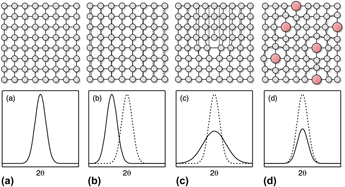Crossref Citations
This article has been cited by the following publications. This list is generated based on data provided by
Crossref.
Wu, Chan-Sheng
Tsai, Ping-Hsiu
Kuo, Chia-Ming
and
Tsai, Che-Wei
2018.
Effect of Atomic Size Difference on the Microstructure and Mechanical Properties of High-Entropy Alloys.
Entropy,
Vol. 20,
Issue. 12,
p.
967.
Su, Yanqing
Xu, Shuozhi
and
Beyerlein, Irene J
2019.
Ab initio-informed phase-field modeling of dislocation core structures in equal-molar CoNiRu multi-principal element alloys.
Modelling and Simulation in Materials Science and Engineering,
Vol. 27,
Issue. 8,
p.
084001.
Ge, Huijuan
and
Tian, Fuyang
2019.
A Review of Ab Initio Calculation on Lattice Distortion in High-Entropy Alloys.
JOM,
Vol. 71,
Issue. 11,
p.
4225.
Sokkalingam, Rathinavelu
Muthupandi, Veerappan
Sivaprasad, Katakam
and
Prashanth, Konda Gokuldoss
2019.
Dissimilar welding of Al0.1CoCrFeNi high-entropy alloy and AISI304 stainless steel.
Journal of Materials Research,
Vol. 34,
Issue. 15,
p.
2683.
Cao, Weitao
Zheng, Mingjie
Ding, Wenyi
Mao, Xiaodong
Wang, Chao
Wang, Wei
and
Xin, Jingping
2019.
Large relrod extension induced by lattice distortion in high entropy alloy.
Materials Research Express,
Vol. 6,
Issue. 6,
p.
066558.
Jafary-Zadeh, Mehdi
Khoo, Khoong Hong
Laskowski, Robert
Branicio, Paulo S.
and
Shapeev, Alexander V.
2019.
Applying a machine learning interatomic potential to unravel the effects of local lattice distortion on the elastic properties of multi-principal element alloys.
Journal of Alloys and Compounds,
Vol. 803,
Issue. ,
p.
1054.
Jansson, U.
and
Lewin, E.
2019.
Carbon-containing multi-component thin films.
Thin Solid Films,
Vol. 688,
Issue. ,
p.
137411.
Anand, G.
Eisenbach, Markus
Goodall, Russell
and
Freeman, Colin L.
2020.
Electron spin mediated distortion in metallic systems.
Scripta Materialia,
Vol. 185,
Issue. ,
p.
159.
Brenne, F.
Mohammed, A.S.K.
and
Sehitoglu, H.
2020.
High resolution atomic scale characterization of dislocations in high entropy alloys: Critical assessment of template matching and geometric phase analysis.
Ultramicroscopy,
Vol. 219,
Issue. ,
p.
113134.
Nygård, Magnus M.
Sławiński, Wojciech A.
Ek, Gustav
Sørby, Magnus H.
Sahlberg, Martin
Keen, David A.
and
Hauback, Bjørn C.
2020.
Local order in high-entropy alloys and associated deuterides – a total scattering and Reverse Monte Carlo study.
Acta Materialia,
Vol. 199,
Issue. ,
p.
504.
Kirnbauer, A.
Kretschmer, A.
Koller, C.M.
Wojcik, T.
Paneta, V.
Hans, M.
Schneider, J.M.
Polcik, P.
and
Mayrhofer, P.H.
2020.
Mechanical properties and thermal stability of reactively sputtered multi-principal-metal Hf-Ta-Ti-V-Zr nitrides.
Surface and Coatings Technology,
Vol. 389,
Issue. ,
p.
125674.
Owen, L.R.
and
Jones, N.G.
2020.
Quantifying local lattice distortions in alloys.
Scripta Materialia,
Vol. 187,
Issue. ,
p.
428.
Lewin, Erik
2020.
Multi-component and high-entropy nitride coatings—A promising field in need of a novel approach.
Journal of Applied Physics,
Vol. 127,
Issue. 16,
Cantor, B.
2021.
Multicomponent high-entropy Cantor alloys.
Progress in Materials Science,
Vol. 120,
Issue. ,
p.
100754.
Sundqvist, Bertil
2021.
Carbon under pressure.
Physics Reports,
Vol. 909,
Issue. ,
p.
1.
2021.
Geslin, Pierre-Antoine
and
Rodney, David
2021.
Microelasticity model of random alloys. Part I: mean square displacements and stresses.
Journal of the Mechanics and Physics of Solids,
Vol. 153,
Issue. ,
p.
104479.
Kaufman, Jonathan
and
Esfarjani, Keivan
2021.
Tunable lattice distortion in MgCoNiCuZnO5 entropy-stabilized oxide.
Journal of Materials Research,
Vol. 36,
Issue. 8,
p.
1615.
Pickering, Ed J.
Carruthers, Alexander W.
Barron, Paul J.
Middleburgh, Simon C.
Armstrong, David E. J.
and
Gandy, Amy S.
2021.
High-Entropy Alloys for Advanced Nuclear Applications.
Entropy,
Vol. 23,
Issue. 1,
p.
98.
Casillas-Trujillo, Luis
Osinger, Barbara
Lindblad, Rebecka
Karlsson, Dennis
Abrikosov, Alexei I.
Fritze, Stefan
von Fieandt, Kristina
Alling, Björn
Hotz, Ingrid
Jansson, Ulf
Abrikosov, Igor A.
and
Lewin, Erik
2021.
Experimental and theoretical evidence of charge transfer in multi-component alloys – how chemical interactions reduce atomic size mismatch.
Materials Chemistry Frontiers,
Vol. 5,
Issue. 15,
p.
5746.



